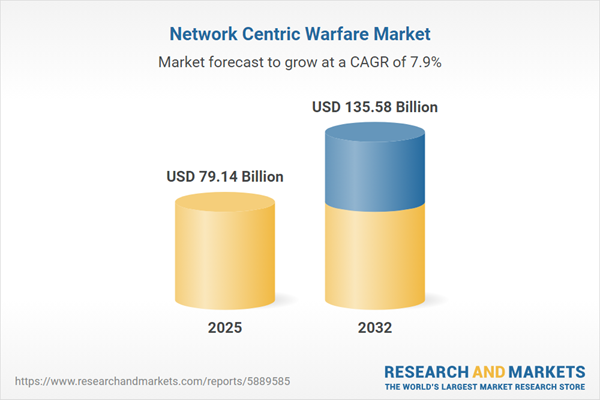Speak directly to the analyst to clarify any post sales queries you may have.
Network-centric warfare is fundamentally reshaping defense strategies, moving modern armed forces toward agile, connected, and resilient multi-domain capabilities. Leaders seeking to maintain situational advantage must now prioritize integrated digital ecosystems delivering secure, real-time data, rapid decision-making, and enhanced operational collaboration.
Market Snapshot: Network Centric Warfare Market
The Network Centric Warfare Market expanded from USD 73.75 billion in 2024 to USD 79.14 billion in 2025. With a projected CAGR of 7.90%, it is set to reach USD 135.58 billion by 2032.
This robust trajectory reflects escalating investments in technological convergence, digital defense integration, and strategic modernization programs across air, land, sea, space, and cyber domains. End users span from military organisations to strategic commercial and civil sectors, driving the adoption of networked solutions that address evolving threat vectors and foster cross-domain coordination.Scope & Segmentation of the Network Centric Warfare Market
- Network Components: Communication systems (mobile networks, radios, satellite communications), hardware infrastructure (routers, servers, switches), and software solutions (data fusion, network management, security suites).
- System Types: Defense systems including electronic attack platforms and support measures, embedded systems such as microprocessors, military-grade computers, and a range of sensors (acoustic, optical).
- Communication Channels: Wired (fiber-optic, terrestrial) and wireless (satellite, mobile) infrastructures, each designed for unique operational requirements.
- Application Areas: Cybersecurity operations, electronic warfare and countermeasures, intelligence and surveillance, military communications, tactical command and control.
- End Users: Civil and commercial organizations—such as disaster recovery and emergency response systems—as well as military branches (air force, army, navy).
- Geographic Regions: Americas (including North and Latin America), Europe, Middle East & Africa (with sub-regions focused on equipment lifecycle and modular networks), and Asia-Pacific (prioritizing secure communications and indigenous R&D).
- Key Companies: Advantech Wireless Technologies Inc. (Baylin Technologies Inc.), Airbus SE, BAE Systems PLC, Bharat Electronics Ltd., CACI International Inc., Cisco Systems, Inc., Elbit Systems Ltd., General Dynamics Corporation, Honeywell International Inc., Israel Aerospace Industries Ltd., Keysight Technologies, Inc., Kratos Defense & Security Solutions, Inc., L3Harris Technologies, Inc., Leonardo S.p.A., Lockheed Martin Corporation, Mitsubishi Electric Corporation, Netcentrics Corporation, Northrop Grumman Corporation, Palo Alto Networks, Inc., Rafael Advanced Defense Systems Ltd., Rheinmetall AG, Ribbon Communications Operating Company, Inc., RTX Corporation, Saab AB, Science Applications International Corporation, Thales Group, The Boeing Company.
Key Takeaways for Strategic Decision-Makers
- The accelerating evolution from platform-centric to network-centric models necessitates agile digital integration and interoperable command structures.
- Defense organizations are adopting open, standardized architectures to future-proof systems, support rapid technology insertion, and streamline maintenance.
- Emerging artificial intelligence and machine learning applications are elevating real-time situational awareness, enhancing threat analytics, and automating response protocols across distributed networks.
- Regional priorities are driving diverse adoption rates; for example, collaborative frameworks in Europe contrast with fast-paced indigenous modernization in Asia-Pacific and resiliency investments in the Americas.
- Industry collaboration among contractors, electronics specialists, and software developers is facilitating the convergence of commercial innovation and military-grade solutions, sustaining operational effectiveness amid evolving threats.
Tariff Impact on Defense Network Supply Chains
Recent tariff escalations in 2025 have added volatility to global supply chains, prompting defense contractors to diversify sourcing, accelerate domestic production, and pursue alternative manufacturing strategies. As a result, stakeholders are integrating predictive analytics and fostering supplier partnerships to assure component continuity and resilience despite ongoing trade policy shifts.
Proven Methodology & Data Sources
This report applies a structured, multi-phase research methodology. Secondary research draws from authoritative defense publications and government white papers. Primary engagement includes expert interviews, workshops, and targeted surveys with procurement officers and program managers. Quantitative analysis is supported by cross-tabulation, regression modeling, and rigorous data triangulation, ensuring reliable and actionable findings.
Why This Report Matters
- Enables leadership teams to benchmark strategies against real-world adoption trends, with clarity on technology integration and operational resilience.
- Equips procurement and risk managers with actionable intelligence on regional trends, supply chain volatility, and evolving commercial frameworks.
- Supports future-readiness planning by highlighting the practical implications of digital defense transformation and coalition interoperability.
Conclusion
As network-centric warfare redefines defense priorities, this report offers decision-makers the critical insights needed to navigate technological convergence, complex supply chains, and evolving global frameworks. Strategic readiness will depend on continued investment in integrated, agile, and resilient digital networks.
Additional Product Information:
- Purchase of this report includes 1 year online access with quarterly updates.
- This report can be updated on request. Please contact our Customer Experience team using the Ask a Question widget on our website.
Table of Contents
3. Executive Summary
4. Market Overview
7. Cumulative Impact of Artificial Intelligence 2025
Companies Mentioned
The companies profiled in this Network Centric Warfare market report include:- Advantech Wireless Technologies Inc. by Baylin Technologies Inc.
- Airbus SE
- BAE Systems PLC
- Bharat Electronics Ltd.
- CACI International Inc.
- Cisco Systems, Inc.
- Elbit Systems Ltd.
- General Dynamics Corporation
- Honeywell International Inc.
- Israel Aerospace Industries Ltd.
- Keysight Technologies, Inc.
- Kratos Defense & Security Solutions, Inc.
- L3Harris Technologies, Inc.
- Leonardo S.p.A.
- Lockheed Martin Corporation
- Mitsubishi Electric Corporation
- Netcentrics Corporation
- Northrop Grumman Corporation
- Palo Alto Networks, Inc.
- Rafael Advanced Defense Systems Ltd.
- Rheinmetall AG
- Ribbon Communications Operating Company, Inc.
- RTX Corporation
- Saab AB
- Science Applications International Corporation
- Thales Group
- The Boeing Company
Table Information
| Report Attribute | Details |
|---|---|
| No. of Pages | 188 |
| Published | November 2025 |
| Forecast Period | 2025 - 2032 |
| Estimated Market Value ( USD | $ 79.14 Billion |
| Forecasted Market Value ( USD | $ 135.58 Billion |
| Compound Annual Growth Rate | 7.9% |
| Regions Covered | Global |
| No. of Companies Mentioned | 28 |









